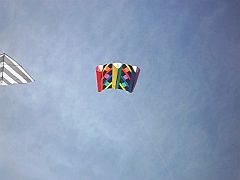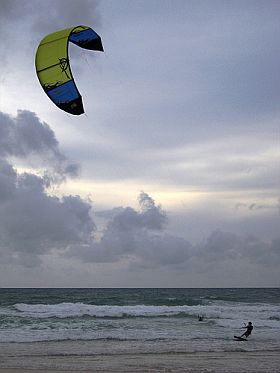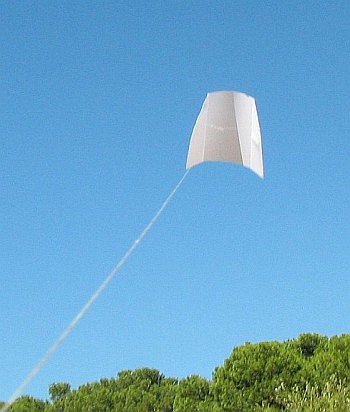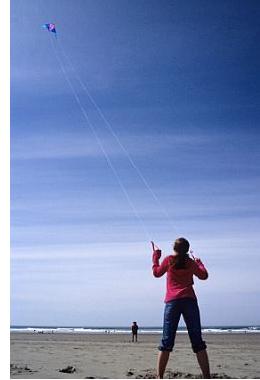- Home Page
- Power Kites
Power Kites, Traction Kites
Take Me for a Ride!
Multi-line power kites first made an appearance way back in the 1970s when the Flexifoil stunt kite became available for anyone to buy. This kite had a single flexible spar running the full length of its leading edge. That's the front edge, if you're not quite up with the terminology. This was a fast kite with plenty of power, and people still fly this design today.
Anyway, a small number of people soon started experimenting with the Flexifoil as a traction kite. They found several ways to drag themselves along—for example, over sand in a small wheeled buggy.
 A power sled!
A power sled!In fact, these days, kite power is used over:
- water
- sand/dirt
- snow
Parafoils are the type most commonly used over dry surfaces.
Down at the beach, leading edge inflatables (LEIs) are the most practical, since they relaunch easily from water.
The kite in the photo is something different again—a single-line power sled. Large kites of this type have ample lifting strength. All manner of inflatable wind art can be hung off the flying line!
Types of Power Kites
Over the years, kite designers have made large kites for specific sports, so there are a lot of different types. I'll avoid getting you bogged down or bored to death; I'll just mention two broad categories:
- power kites
- traction kites
Some people use this name for all two, three, four, or five-line flexible kites. Many other people, including me, divide these into two- or three-line "power kites" and four- or five-line "traction kites." There is a big range of sizes available, and cost depends a lot on size.
Now, are you totally confused about exactly what is a power and what is a traction kite?
 Photo courtesy of Mike
Photo courtesy of MikeWhat's the real difference? I'll try and sum it up for you.
Power kites are at the smaller and cheaper end and are used mainly for stunt flying or just having fun. Yes, they are just another kind of stunt kite.
A small power kite is pretty fast through the air, which is part of the thrill of flying it! There's one in the photo.
However, if they are 3 square meters (about 30 square feet) or bigger in area, they pull quite a bit. Naturally, people then think about using them to pull along small land buggies, for example.
Depending on wind conditions, there's nothing to stop you flying a four-line traction kite as a rather expensive and impressive stunt kite! The extra brake lines let you turn the kite with less arm movement than the two-line variety. Also, the brake lines are handy for bringing the kite down onto the ground with a bit more control.
 Photo courtesy of Jan
Photo courtesy of Jan
The beach picture shows a kite surfer in action.
With four or more lines dragging through the air, and for other aerodynamic reasons, traction kites are a bit slower than the smaller multi-line kites. You can get a feel for how they handle by flying a trainer kite over sand.
Most surfing kites are not parafoils. Can see the leading-edge spar and a few other shorter spars helping the kite keep its shape?
Some kite surfers these days are into kite racing around a course, much like a boat race.
Although it's possible to be self-taught, many people these days sign up for kite-surfing lessons. This way, progress is quicker, and important safety lessons are learned the easy way.
I might just mention here that some traction kites are built purely for speed, compared to other kites of the same size. These are "racing kites," and if you get one, don't expect it to be as easy to fly as other traction kites!
Power Kites in Action
OK, how do people fly this kind of kite these days? What a big topic! This type being so popular, the manufacturers have managed to cater for just about everyone.
Young children can fly the smallest two-line power kites under supervision while down at the beach. At the other end, top-notch athletes push the limits doing freestyle tricks over snow or in the surf with other kite boarders, using very expensive LEIs.
The top-end traction kites are more like aircraft than toys. That's not at all surprising when you consider that some parafoil kites used for traction are made by paraglider manufacturers! The cost of these flying wonders can exceed US$1000.
Mind you, if you are a very patient person, you could save a bundle by making power kites from scratch. There would be heaps of sewing involved, believe me.
It's wise to have a chat with the experts about what kind of power kiting you'd like to do, before actually laying down your cash for a kite!
Wind-Speed Handy Reference
Light Air
1-5 kph
1-3 mph
1-3 knts
Beaufort 1
Light breeze
6–11 kph
4–7 mph
4–6 knts
Beaufort 2
Gentle ...
12–19 kph
8–12 mph
7–10 knts
Beaufort 3
Moderate ...
20–28 kph
13–18 mph
11–16 knts
Beaufort 4
Fresh ...
29–38 kph
19–24 mph
17–21 knts
Beaufort 5
Strong ...
39–49 kph
25–31 mph
22–27 knts
Beaufort 6
High Wind
50-61 kph
32-38 mph
28-33 knts
Beaufort 7
Gale
62-74 kph
39-46 mph
34-40 knts
Beaufort 8
Time for a Big List. I love lists; I'm one of those list-driven types of people. :-) Even if you're not like that, a list is a great way of summarizing information. It struck me that power or traction kites are used in a huge number of ways, so here is the biggest list of power-kiting activities you will find on the Internet:
- pure fun, just aimlessly flying a multi-line parafoil kite as far as possible in all directions
- learning some stunts and practicing them for fun, or competing in kite-flying contests
- in a controlled way, letting yourself get dragged across dirt, sand, ice, or grass
- breaking silly records, such as in September 1988 when a 43 square meter (460 square foot) parafoil broke the record for the world's largest stunt kite
- breaking sports records, such as the C-class unlimited speed-sailing record, with a set of catamaran hulls powered by a winch-controlled stack of Flexifoils!
- kitesurfing or getting dragged along while riding a surfboard
- kitesurfing while riding a windsurfing board
- kitesurfing on a kiteboard
- bodysurfing, powered by a traction kite
- snow kiting or getting dragged along while riding a snowboard
- kiteboarding on a land or all-terrain board
- kiteboarding on a mountainboard
- kite sailing a boat on water
- kite sailing a sled on ice
- getting dragged along while riding ice skates, roller skates, or rollerblades
- kite skiing over snow
- kite skiing uphill is now a part of Scottish skiing history!
- riding in a land-kite-powered buggy
- getting dragged along while on water skis
- dangerous: kite jumping, where you let yourself leave the ground for as long as you dare
- even more dangerous: man lifting, where a large tethered traction kite lifts someone high off the ground
"Freestyle" kite skiing and kiteboarding have both seen big increases in popularity as well as kitesurfing. Kite landboarding gear has many similarities to the gear used over water and snow.
If you have a think about it, it's not hard to make up a few kiting sports of your own. Here's my little effort, but don't try these at home. ;-)
- kitebagging: sliding across wet grass while wearing a large plastic garbage bag (very doable, I'm sure)
- kiteduning: slipping over and around sand dunes on your bare feet, "getting some air" once in a while (mmm how practical is this)
- kitevertising: using your kite as a billboard at public events (not as silly as it sounds)
- kitebiking: using your feet to steer and your hands for the kite (you'd be stupid to try this)
- wet stunting: flying your kite underwater in tidal currents while scuba diving (I wasn't serious, but then I saw some pics of people actually doing this!)
I think I'll stop before it gets too silly.
As you can see, just about any way of moving across the earth's surface might be tried by a keen traction kiter!
Here are a few notes on kite safety that might prove handy, particularly for beginners.
The history of power kites extends back to the 70s. Using big kites to pull you along isn't a new idea!



